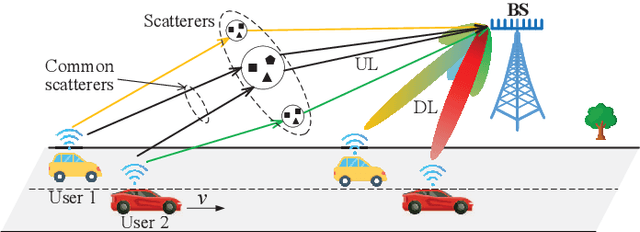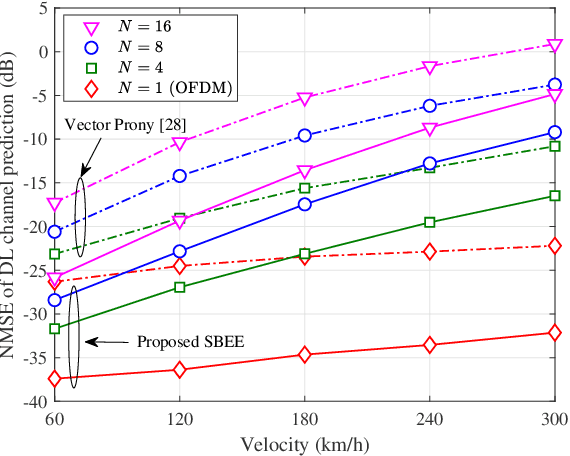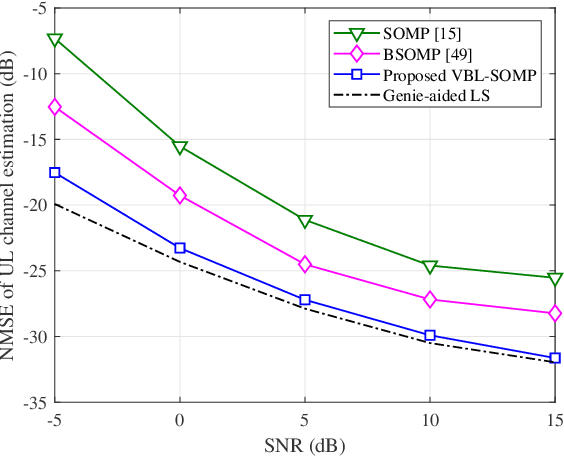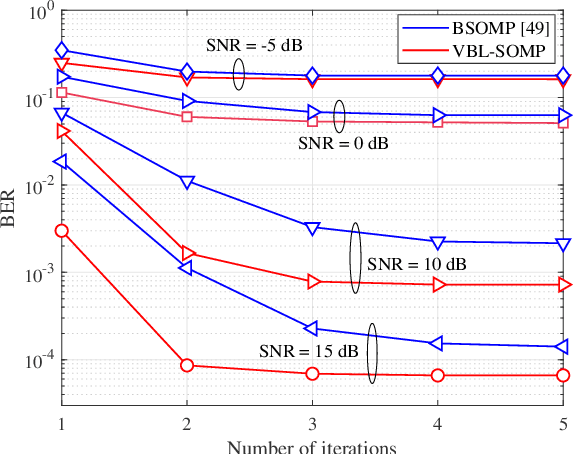Yujie Liu
DFT-s-OFDM with Chirp Modulation
Aug 06, 2025Abstract:In this paper, a new waveform called discrete Fourier transform spread orthogonal frequency division multiplexing with chirp modulation (DFT-s-OFDM-CM) is proposed for the next generation of wireless communications. The information bits are conveyed by not only Q-ary constellation symbols but also the starting frequency of chirp signal. It could maintain the benefits provided by the chirped discrete Fourier transform spread orthogonal frequency division multiplexing (DFT-s-OFDM), e.g., low peak-to-average power ratio (PAPR), full frequency diversity exploitation, etc. Simulation results confirm that the proposed DFT-s-OFDM-CM could achieve higher spectral efficiency while keeping the similar bit error rate (BER) to that of chirped DFT-s-OFDM. In addition, when maintaining the same spectral efficiency, the proposed DFT-s-OFDM-CM with the splitting of information bits into two streams enables the use of lower-order constellation modulation and offers greater resilience to noise, resulting in a lower BER than the chirped DFT-s-OFDM.
Attributed Graph Clustering with Multi-Scale Weight-Based Pairwise Coarsening and Contrastive Learning
Jul 28, 2025Abstract:This study introduces the Multi-Scale Weight-Based Pairwise Coarsening and Contrastive Learning (MPCCL) model, a novel approach for attributed graph clustering that effectively bridges critical gaps in existing methods, including long-range dependency, feature collapse, and information loss. Traditional methods often struggle to capture high-order graph features due to their reliance on low-order attribute information, while contrastive learning techniques face limitations in feature diversity by overemphasizing local neighborhood structures. Similarly, conventional graph coarsening methods, though reducing graph scale, frequently lose fine-grained structural details. MPCCL addresses these challenges through an innovative multi-scale coarsening strategy, which progressively condenses the graph while prioritizing the merging of key edges based on global node similarity to preserve essential structural information. It further introduces a one-to-many contrastive learning paradigm, integrating node embeddings with augmented graph views and cluster centroids to enhance feature diversity, while mitigating feature masking issues caused by the accumulation of high-frequency node weights during multi-scale coarsening. By incorporating a graph reconstruction loss and KL divergence into its self-supervised learning framework, MPCCL ensures cross-scale consistency of node representations. Experimental evaluations reveal that MPCCL achieves a significant improvement in clustering performance, including a remarkable 15.24% increase in NMI on the ACM dataset and notable robust gains on smaller-scale datasets such as Citeseer, Cora and DBLP.
* The source code for this study is available at https://github.com/YF-W/MPCCL
Basis Expansion Extrapolation based Long-Term Channel Prediction for Massive MIMO OTFS Systems
Jul 02, 2025



Abstract:Massive multi-input multi-output (MIMO) combined with orthogonal time frequency space (OTFS) modulation has emerged as a promising technique for high-mobility scenarios. However, its performance could be severely degraded due to channel aging caused by user mobility and high processing latency. In this paper, an integrated scheme of uplink (UL) channel estimation and downlink (DL) channel prediction is proposed to alleviate channel aging in time division duplex (TDD) massive MIMO-OTFS systems. Specifically, first, an iterative basis expansion model (BEM) based UL channel estimation scheme is proposed to accurately estimate UL channels with the aid of carefully designed OTFS frame pattern. Then a set of Slepian sequences are used to model the estimated UL channels, and the dynamic Slepian coefficients are fitted by a set of orthogonal polynomials. A channel predictor is derived to predict DL channels by iteratively extrapolating the Slepian coefficients. Simulation results verify that the proposed UL channel estimation and DL channel prediction schemes outperform the existing schemes in terms of normalized mean square error of channel estimation/prediction and DL spectral efficiency, with less pilot overhead.
MOOSE-Chem2: Exploring LLM Limits in Fine-Grained Scientific Hypothesis Discovery via Hierarchical Search
May 25, 2025



Abstract:Large language models (LLMs) have shown promise in automating scientific hypothesis generation, yet existing approaches primarily yield coarse-grained hypotheses lacking critical methodological and experimental details. We introduce and formally define the novel task of fine-grained scientific hypothesis discovery, which entails generating detailed, experimentally actionable hypotheses from coarse initial research directions. We frame this as a combinatorial optimization problem and investigate the upper limits of LLMs' capacity to solve it when maximally leveraged. Specifically, we explore four foundational questions: (1) how to best harness an LLM's internal heuristics to formulate the fine-grained hypothesis it itself would judge as the most promising among all the possible hypotheses it might generate, based on its own internal scoring-thus defining a latent reward landscape over the hypothesis space; (2) whether such LLM-judged better hypotheses exhibit stronger alignment with ground-truth hypotheses; (3) whether shaping the reward landscape using an ensemble of diverse LLMs of similar capacity yields better outcomes than defining it with repeated instances of the strongest LLM among them; and (4) whether an ensemble of identical LLMs provides a more reliable reward landscape than a single LLM. To address these questions, we propose a hierarchical search method that incrementally proposes and integrates details into the hypothesis, progressing from general concepts to specific experimental configurations. We show that this hierarchical process smooths the reward landscape and enables more effective optimization. Empirical evaluations on a new benchmark of expert-annotated fine-grained hypotheses from recent chemistry literature show that our method consistently outperforms strong baselines.
ResearchBench: Benchmarking LLMs in Scientific Discovery via Inspiration-Based Task Decomposition
Mar 27, 2025



Abstract:Large language models (LLMs) have demonstrated potential in assisting scientific research, yet their ability to discover high-quality research hypotheses remains unexamined due to the lack of a dedicated benchmark. To address this gap, we introduce the first large-scale benchmark for evaluating LLMs with a near-sufficient set of sub-tasks of scientific discovery: inspiration retrieval, hypothesis composition, and hypothesis ranking. We develop an automated framework that extracts critical components - research questions, background surveys, inspirations, and hypotheses - from scientific papers across 12 disciplines, with expert validation confirming its accuracy. To prevent data contamination, we focus exclusively on papers published in 2024, ensuring minimal overlap with LLM pretraining data. Our evaluation reveals that LLMs perform well in retrieving inspirations, an out-of-distribution task, suggesting their ability to surface novel knowledge associations. This positions LLMs as "research hypothesis mines", capable of facilitating automated scientific discovery by generating innovative hypotheses at scale with minimal human intervention.
Neural Network Surrogate Model for Junction Temperature and Hotspot Position in $3$D Multi-Layer High Bandwidth Memory (HBM) Chiplets under Varying Thermal Conditions
Mar 06, 2025Abstract:As the demand for computational power increases, high-bandwidth memory (HBM) has become a critical technology for next-generation computing systems. However, the widespread adoption of HBM presents significant thermal management challenges, particularly in multilayer through-silicon-via (TSV) stacked structures under varying thermal conditions, where accurate prediction of junction temperature and hotspot position is essential during the early design. This work develops a data-driven neural network model for the fast prediction of junction temperature and hotspot position in 3D HBM chiplets. The model, trained with a data set of $13,494$ different combinations of thermal condition parameters, sampled from a vast parameter space characterized by high-dimensional combination (up to $3^{27}$), can accurately and quickly infer the junction temperature and hotspot position for any thermal conditions in the parameter space. Moreover, it shows good generalizability for other thermal conditions not considered in the parameter space. The data set is constructed using accurate finite element solvers. This method not only minimizes the reliance on costly experimental tests and extensive computational resources for finite element analysis but also accelerates the design and optimization of complex HBM systems, making it a valuable tool for improving thermal management and performance in high-performance computing applications.
XRAG: eXamining the Core -- Benchmarking Foundational Components in Advanced Retrieval-Augmented Generation
Dec 24, 2024Abstract:Retrieval-augmented generation (RAG) synergizes the retrieval of pertinent data with the generative capabilities of Large Language Models (LLMs), ensuring that the generated output is not only contextually relevant but also accurate and current. We introduce XRAG, an open-source, modular codebase that facilitates exhaustive evaluation of the performance of foundational components of advanced RAG modules. These components are systematically categorized into four core phases: pre-retrieval, retrieval, post-retrieval, and generation. We systematically analyse them across reconfigured datasets, providing a comprehensive benchmark for their effectiveness. As the complexity of RAG systems continues to escalate, we underscore the critical need to identify potential failure points in RAG systems. We formulate a suite of experimental methodologies and diagnostic testing protocols to dissect the failure points inherent in RAG engineering. Subsequently, we proffer bespoke solutions aimed at bolstering the overall performance of these modules. Our work thoroughly evaluates the performance of advanced core components in RAG systems, providing insights into optimizations for prevalent failure points.
Critic-V: VLM Critics Help Catch VLM Errors in Multimodal Reasoning
Dec 02, 2024



Abstract:Vision-language models (VLMs) have shown remarkable advancements in multimodal reasoning tasks. However, they still often generate inaccurate or irrelevant responses due to issues like hallucinated image understandings or unrefined reasoning paths. To address these challenges, we introduce Critic-V, a novel framework inspired by the Actor-Critic paradigm to boost the reasoning capability of VLMs. This framework decouples the reasoning process and critic process by integrating two independent components: the Reasoner, which generates reasoning paths based on visual and textual inputs, and the Critic, which provides constructive critique to refine these paths. In this approach, the Reasoner generates reasoning responses according to text prompts, which can evolve iteratively as a policy based on feedback from the Critic. This interaction process was theoretically driven by a reinforcement learning framework where the Critic offers natural language critiques instead of scalar rewards, enabling more nuanced feedback to boost the Reasoner's capability on complex reasoning tasks. The Critic model is trained using Direct Preference Optimization (DPO), leveraging a preference dataset of critiques ranked by Rule-based Reward~(RBR) to enhance its critic capabilities. Evaluation results show that the Critic-V framework significantly outperforms existing methods, including GPT-4V, on 5 out of 8 benchmarks, especially regarding reasoning accuracy and efficiency. Combining a dynamic text-based policy for the Reasoner and constructive feedback from the preference-optimized Critic enables a more reliable and context-sensitive multimodal reasoning process. Our approach provides a promising solution to enhance the reliability of VLMs, improving their performance in real-world reasoning-heavy multimodal applications such as autonomous driving and embodied intelligence.
DDRN:a Data Distribution Reconstruction Network for Occluded Person Re-Identification
Oct 09, 2024



Abstract:In occluded person re-identification(ReID), severe occlusions lead to a significant amount of irrelevant information that hinders the accurate identification of individuals. These irrelevant cues primarily stem from background interference and occluding interference, adversely affecting the final retrieval results. Traditional discriminative models, which rely on the specific content and positions of the images, often misclassify in cases of occlusion. To address these limitations, we propose the Data Distribution Reconstruction Network (DDRN), a generative model that leverages data distribution to filter out irrelevant details, enhancing overall feature perception ability and reducing irrelevant feature interference. Additionally, severe occlusions lead to the complexity of the feature space. To effectively handle this, we design a multi-center approach through the proposed Hierarchical SubcenterArcface (HS-Arcface) loss function, which can better approximate complex feature spaces. On the Occluded-Duke dataset, we achieved a mAP of 62.4\% (+1.1\%) and a rank-1 accuracy of 71.3\% (+0.6\%), surpassing the latest state-of-the-art methods(FRT) significantly.
Chirped DFT-s-OFDM: A new single-carrier waveform with enhanced LMMSE noise suppression
Aug 13, 2024



Abstract:In this correspondence, a new single-carrier waveform, called chirped discrete Fourier transform spread orthogonal frequency division multiplexing (DFT-s-OFDM), is proposed for the sixth generation of communications. By chirping DFT-s-OFDM in the time domain, the proposed waveform maintains the low peak-to-average-power ratio (PAPR) of DFT-s-OFDM. Thanks to full-band transmission and symbols retransmission enabled by chirping and discrete Fourier transform (DFT) precoding, the proposed waveform can enhance noise suppression of linear minimum mean square error equalization. Its bit error rate (BER) upper bound and diversity order are derived using pairwise error probability. Simulation results confirm that the proposed waveform outperforms the state-of-the-art waveforms in terms of BER, output signal-to-noise-ratio, and PAPR.
 Add to Chrome
Add to Chrome Add to Firefox
Add to Firefox Add to Edge
Add to Edge